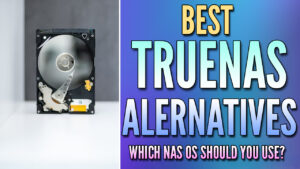In this article, we’re going to look at TrueNAS Core vs Scale and compare both solutions for home lab and enterprise environments.
TrueNAS Core and Scale are two NAS operating systems designed and developed by iXsystems. While both, TrueNAS Core and Scale are similar, they differ in architecture, functionality, and performance. This article will compare TrueNAS and Scale side-by-side to determine the best NAS operating system you can run.
TrueNAS Core vs Scale: Side-by-Side Comparison
Before comparing both TrueNAS Core or Scale, we’ll take a look at exactly what TrueNAS Core and Scale are. Then, we’ll take a look at the major differences between TrueNAS Core vs Scale to help you make an informed decision.
What is TrueNAS Core and TrueNAS Scale?
TrueNAS Core (formerly known as FreeNAS) is a NAS operating system designed on an OpenZFS file system and is based on FreeBSD.
As a NAS operating system, administrators can create shared folders that can be accessed via SMB, NFS, or iSCSI. You can also configure different permission levels, create groups, add users, and much more.
The biggest benefit of Core is that it’s incredibly stable. TrueNAS core has been around since roughly 2005 (though it went by the name FreeNAS for many years).
There are some specific features to Core like Jails and Plugins, but shares many similarities with TrueNAS Scale that we’ll explore below.
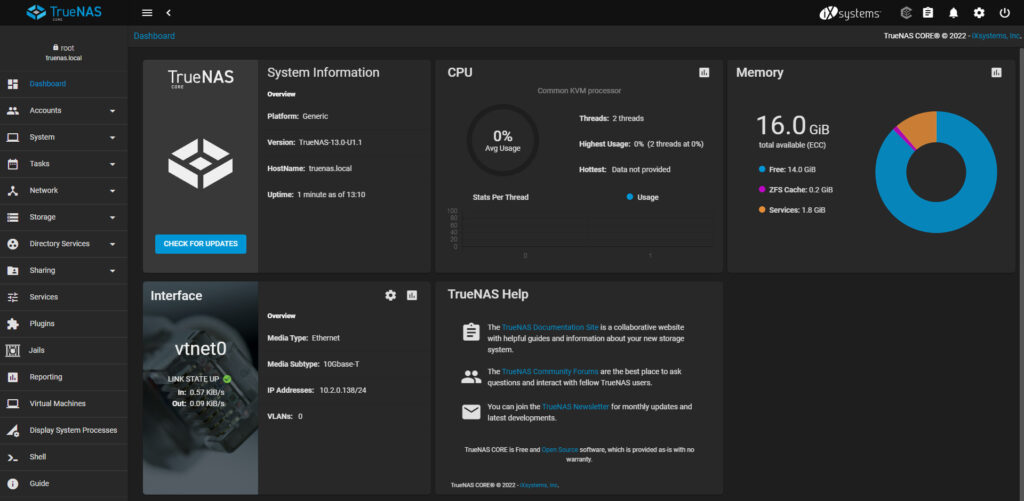
TrueNAS Scale also runs the OpenZFS file system and is the latest operating system created by iXsystems. Scale is very similar to TrueNAS Core, but it’s built on Debian-Linux as opposed to FreeBSD.
TrueNAS Scale provides HCI (Hyper-Converged Infrastructure) which allows you to create VMs and Linux containers. Scale also gives you a ton of options for scalability that Core doesn’t.
TrueNAS Scale has slowly progressed over the past few years and is now the premiere offering by iXsystems, and the new release coming (24.10) is going to be a HUGE update for TrueNAS in general, with features like ZFS expansion, true Docker support, and more.
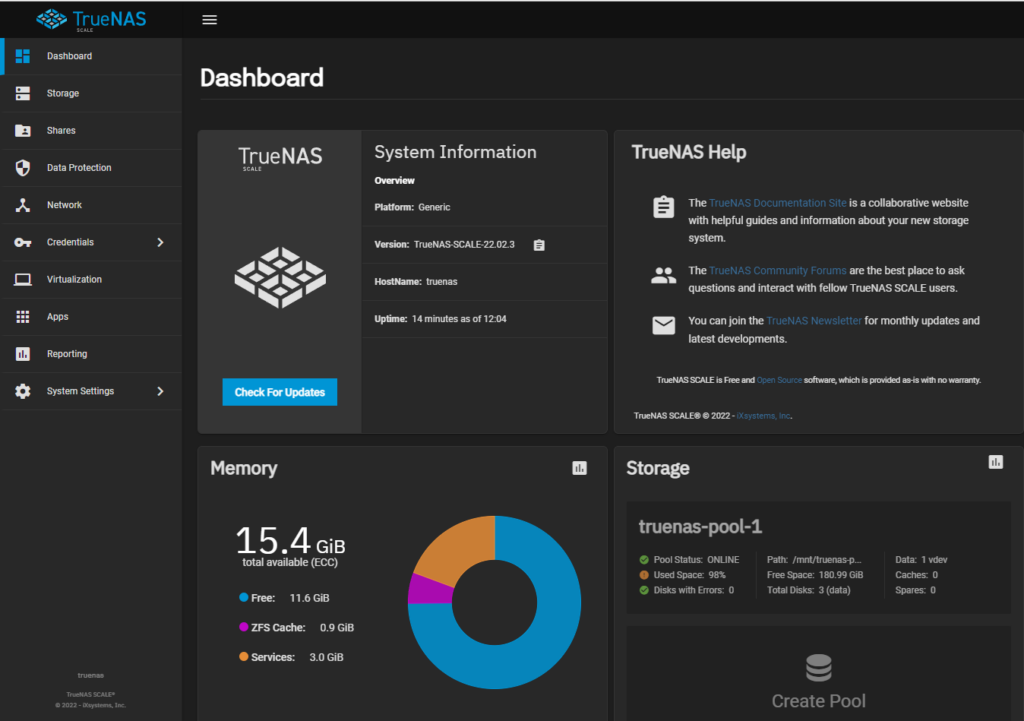
Features of TrueNAS: TrueNAS Core vs Scale
TrueNAS Scale is meant for large-scale environments and data centers. The whole goal of Scale is to give you the flexibility to scale out your setup to have hundreds of petabytes of storage space if needed. It also gives you the option of using high-availability, something that’s not available with Core.
From a home user’s perspective, this type of scalability is unnecessary, but one huge benefit of TrueNAS Scale is that it allows you to run virtual machines and containers directly inside of the OS.
There are also awesome, easy-to-install apps like Nextcloud and more. This allows users to set up one flexible server that will run your VMs and Containers, and will also operate as a rock-solid NAS.
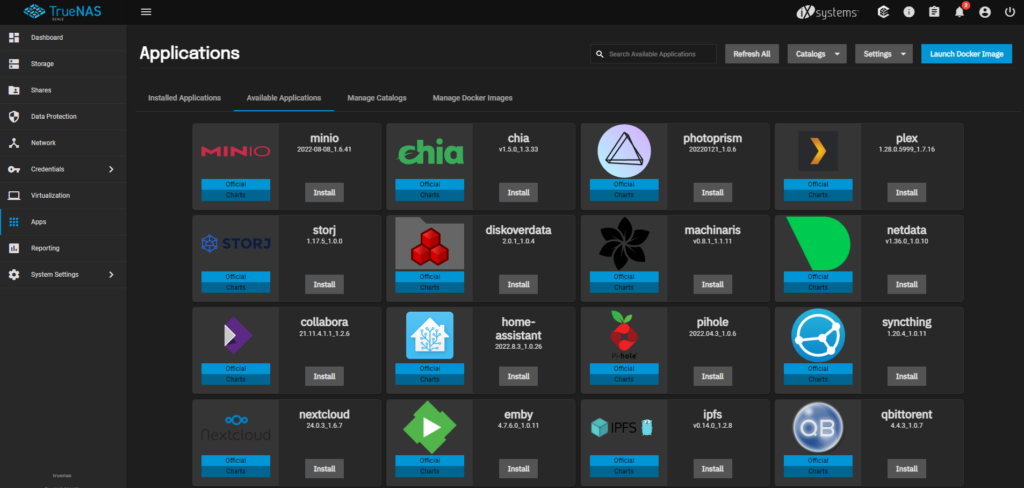
Since Core is based on FreeBSD, a lot of the Debian Linux benefits of TrueNAS Scale are missing. However, you do get the benefit of having an incredibly reliable NAS operating system that has been around since 2005.
Looking at this point alone, it’s reasonable to say that from a pure stability perspective, Core is superior (at least at this time), but TrueNAS Scale has come a LONG way and rivals the stability that Core has always had, with better overall hardware support.
In TrueNAS Core also have the option of installing plugins (there are iXsystems and community options) that will operate extremely similarly to Scale’s Apps. The main difference with plugins is that they are installed inside Jails.
Finally, you can create basic VMs, though Scale should be installed if you need more robust VM capabilities as it uses KVM. Overall, both versions have significant differences when it comes to features.
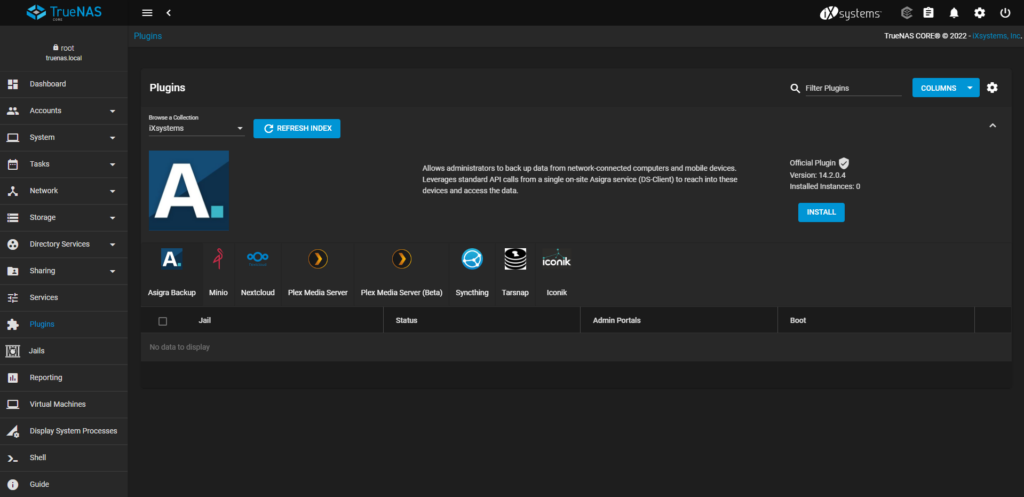
It’s also important to note that while Scale may seem like it offers more as far as usability goes, the key to a NAS operating system is…to be a NAS. Since Core excels in this area, it’s reasonable to choose stability over features, especially if those features will all be “nice to haves”.
There are also tons of key features that both platforms share, like snapshots, bit-rot correction, replication, remote management, deduplication, and more.
With all of this said, TrueNAS Core is no longer being developed and appears to be in a long-term stability phase as opposed to an OS looking to be advanced with new features, so if you’re looking for more features, TrueNAS Scale is the way to go.
Additional Features of TrueNAS Core
- Fusion Pools: The fusion pool (also known as ZFS allocation classes, ZFS special vdevs, and metadata vdevs) is a significant feature of the Core operating system. Fusion pools are ideal for speeding up file-based operations. One key benefit is that they can increase the speed of metadata requests.
- API Keys: The API keys feature of Core saves you from sharing the root password to your server. API keys simplify the automation of the Core operating system by allowing you to utilize them for services that interact with your NAS
- VPN Support: If you don’t want to use an enterprise VPN, you can benefit from the native VPN support feature of TrueNAS Core. Core gives you a simple OpenVPN configuration section that will allow you to connect to your local network from an outside location.
- Native Encryption: Core offers native encryption and can be used in a variety of ways.
Additional Features of TrueNAS Scale
- Scalable Software-Defined Infrastructure: Scale combines the capabilities of GlusterFS and OpenZFS to give scale-out ZFS capabilities with impressive data management. You can use a single hyper-converged node in your office or home to get a highly available and scalable software-defined infrastructure.
- Linux Container Ecosystem: Scale gives access to an established Linux container ecosystem, making application deployment much easier and faster. You can also make customized applications with the help of Docker containers (official support coming in 24.10) and KVM virtual machines.
- Manage Storage Fleets & Clusters: Scale allows you to cluster many systems together and manage them all with the help of TrueCommand.
Feature Differences Between TrueNAS Core vs Scale
Below are a few additional key feature differences between TrueNAS Core vs Scale:
- Scalability: TrueNAS Scale (Scale stands for “Scaled-Out”) and is designed for horizontal scalability. It allows multiple nodes to be clustered together to deliver high availability, shared storage, and improved performance. Alternatively, Core is more of a single-system solution.
- Virtualization and Containers: Both systems support virtualization. However, Scale has integrated support for Linux-native technologies like KVM for virtual machines and Docker for containerization (24.10 release in Scale). Core utilizes FreeBSD’s bhyve for virtual machines and Jails for an isolated environment.
- High Availability: Both Core and Scale offer high-availability solutions. However, Scale leverages Linux-based technologies to provide active-active clustering for real-time data synchronization and failover.
- Community and Support: TrueNAS Core, being the successor of FreeNAS, has always had a more established community and extensive support documentation. TrueNAS Scale was always lacking in this area, but since TrueNAS Scale is now the premiere offering by iXsystems, Scale has similar support in this area.
- Docker: Natively, TrueNAS Scale supported Docker while Core didn’t, but as of late 2023, Scale switched to the containerd runtime, meaning that Docker is no longer natively supported with Scale, but it’s coming in v24.10 (finally released!). There are still tons of applications available right now, but more is coming in v24.10.
| TrueNAS Core | TrueNAS Scale | |
|---|---|---|
| Based On | FreeBSD | Debian Linux |
| File System | ZFS | ZFS |
| Scalability | Good for small to medium setups | Designed for high scalability |
| Virtualization | Limited (bhyve) | Full (KVM, containers) |
| Plugin System | Jails (FreeBSD-based) | Optimized for large-scale |
| Performance | Stable and reliable | Optimized for large scale |
| Best For | General purpose NAS | Large-scale, virtualization |
Pricing & User Experience: TrueNAS Core vs Scale
When comparing the pricing of TrueNAS Core vs Scale, both are open-source and free to use. However, if you intend on using TrueNAS in an enterprise environment, you can purchase hardware directly from iXsystems which will come with professional enterprise support.
From a pricing perspective, there really isn’t much of a difference between TrueNAS Core and Scale.
User Experience of TrueNAS
When comparing the user interface between TrueNAS Core or Scale, they both offer a fairly similar web interface that you use to manage each environment.
They are both installed on a USB drive on bare metal (which is used as the boot drive) or can be installed as a virtual machine on a hypervisor like Proxmox or ESXi. Due to this, Core and Scale do not rely on the storage disks to run the operating system.
The key difference to consider when it comes to user experience is the overall requirements you have. With TrueNAS Scale, you have the option of running VMs and Containers, and while you can run VMs in TrueNAS Core, I’d give the nod to TrueNAS Scale in this regard.
With that said, if you’re strictly looking for a NAS operating system with the intention of using SMB, NFS, S3, or iSCSI with no intentions of scaling the environment, TrueNAS Core is a great option, but again, is no longer being developed from a feature perspective.
Which Should You Use: TrueNAS Core or Scale?
As of September of 2024, you should use TrueNAS Scale as Core is no longer being developed from a feature perspective. Features like ZFS expansion and native Docker support is coming in the next release of TrueNAS Scale, while Core will continue to operate the same way it always has, which will provide reliability, with fewer features.

Another important thing to remember is that TrueNAS Scale was developed with scalability in mind. This means that for larger deployments (where you’d like to use clusters), it’ll be easier to manage with Scale as opposed to Core, making it the correct product for those types of environments.
If you simply want to set up an individual NAS, as long as your hardware will work with both options, you can technically pick either, but again, you should probably start off with Scale for the future features that are coming.
Conclusion & Final Thoughts on our TrueNAS Comparison
This article looked at TrueNAS Core vs Scale, with the goal of explaining some of their differences to help you make an informed decision on if TrueNAS Core or Scale is the best option for you. The biggest downside of TrueNAS Core at this point is that it’s not being developed further, which is great if you only want a reliable NAS, but will slowly have far fewer features than Scale has.
To be clear, you really can’t go wrong with TrueNAS Core or Scale as they’re both great operating systems, but the key differences above should be what sways you one way or the other.



